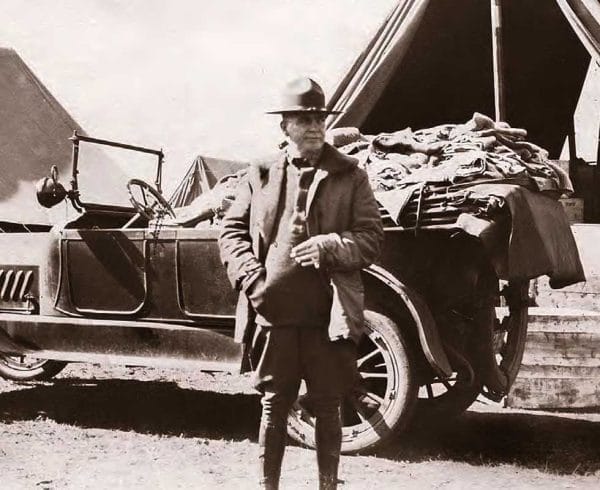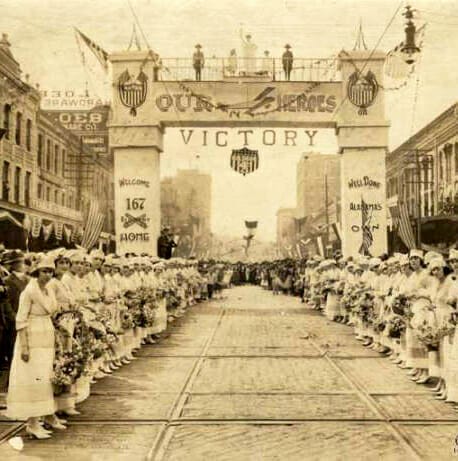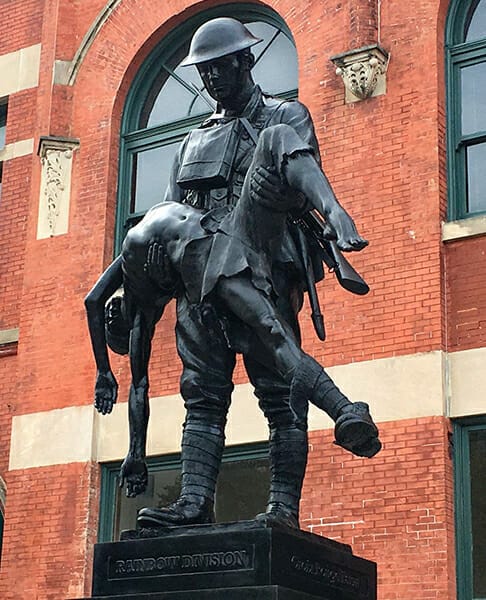167th Alabama Infantry Regiment
 167th Infantry Regiment Coat of Arms
Although not designated so officially until 1917, Alabama’s 167th Infantry Regiment traces its lineage back to 1836. It fought as the Fourth Alabama Infantry Regiment in the American Civil War and later with distinction in France during World War I and in the Pacific during World War II. As a National Guard unit, it was federalized during the 1960s to protect protestors in the state who were advocating for civil rights. More recently, elements of the unit have served as part of the coalition forces in the military operations in Iraq and Afghanistan.
167th Infantry Regiment Coat of Arms
Although not designated so officially until 1917, Alabama’s 167th Infantry Regiment traces its lineage back to 1836. It fought as the Fourth Alabama Infantry Regiment in the American Civil War and later with distinction in France during World War I and in the Pacific during World War II. As a National Guard unit, it was federalized during the 1960s to protect protestors in the state who were advocating for civil rights. More recently, elements of the unit have served as part of the coalition forces in the military operations in Iraq and Afghanistan.
Nineteenth Century Service
Primarily operating as state militia or state troops throughout the nineteenth century, the unit was called occasionally into federal service, notably during the so-called Indian Wars against the Seminoles and during the Mexican War. During the American Civil War, the unit mustered into Confederate service at Dalton, Georgia, and fought in the eastern theater from First Manassas until surrender in April 1865 at Appomattox Court House, Virginia. Some of the more notable battles in which the unit participated include Second Manassas, Sharpsburg (Antietam), Gettysburg, Chickamauga, The Wilderness, and Spotsylvania Court House. The unit surrendered 202 men at Appomattox on April 12, 1865. A total of 1,422 men served with the unit over the course of the war, and of that number approximately 240 died in battle and nearly 100 of disease. At the end of nineteenth century (1898-99), the state militias became National Guard troops, at which time this unit was known as the Fourth Alabama Infantry Regiment.
The Fourth Alabama in Mexico
 William P. Screws
In 1916 and early 1917, the Fourth Alabama participated in the nationwide call of National Guard units to federal service for guard duty along the United States’s southwestern border with Mexico in Arizona, New Mexico, and Texas. They were positioned there, as the Mexican Border Service, after a raid on Columbus, New Mexico, by forces under the command of Mexican revolutionary general Francisco “Pancho” Villa. Although the success of this effort has been questioned by historians, the true value of the Mexican Border Service proved to be preparing the relatively untested, undisciplined, and untrained troops for their later service in World War I. Forced to abide by regular Army standards for months, the guardsmen were better prepared for active service when the United States entered the war against Germany in April 1917. The Alabama troops also benefited from the experience of their commander, Lt. Col. William P. Screws, a former regular Army officer with years of active service and who, since 1912, had served as the inspector of the Alabama troops before becoming commander of the Fourth Alabama.
William P. Screws
In 1916 and early 1917, the Fourth Alabama participated in the nationwide call of National Guard units to federal service for guard duty along the United States’s southwestern border with Mexico in Arizona, New Mexico, and Texas. They were positioned there, as the Mexican Border Service, after a raid on Columbus, New Mexico, by forces under the command of Mexican revolutionary general Francisco “Pancho” Villa. Although the success of this effort has been questioned by historians, the true value of the Mexican Border Service proved to be preparing the relatively untested, undisciplined, and untrained troops for their later service in World War I. Forced to abide by regular Army standards for months, the guardsmen were better prepared for active service when the United States entered the war against Germany in April 1917. The Alabama troops also benefited from the experience of their commander, Lt. Col. William P. Screws, a former regular Army officer with years of active service and who, since 1912, had served as the inspector of the Alabama troops before becoming commander of the Fourth Alabama.
As tensions escalated between the United States and Germany, and the prospect of U.S. entry into World War I became increasingly likely, guardsmen along the Mexican border were recalled to their home states. The Fourth Alabama, along with Alabama’s other Guard units, returned to Montgomery, Montgomery County. They were stationed in the city’s Vandiver Park, which was soon to be part of Camp Sheridan. Over the next several months, these men performed guard duty around the state at strategically significant sites, particularly railroads, dams, and bridges. In early April, the United States declared war on Germany and other Central Powers nations, and the guardsmen’s training and preparation took on more urgency.
World War I Service
On August 15, 1917, the federal government designated the Fourth Alabama Infantry as the 167th Infantry, part of the Eighty-fourth Brigade, Forty-second Division. The 167th joined similar regiments from Iowa, Ohio, and New York, as well as various other units from about 20 other states to form the Forty-second Division, best known as the Rainbow Division. The 167th entrained for Camp Mills, Long Island, New York, merging there with the other states’ guardsmen for more training, drilling, and equipping before embarking for Liverpool, Great Britain, en route to the trenches and battlefields of the western front. From Liverpool, the men moved to Le Havre, France, and soon thereafter dispersed to various training points in France near the front lines. Although the 167th received some additional outside officers, the great majority of the personnel were Alabamians.
 Montgomery Military Parade, 1919
Once in France, the men began another round of training. Several men noted hardships in letters and diaries, including snowy weather, sleeping in hay lofts, and eating cold meals. Intensive training continued until late February 1918, when the first elements of the 167th entered the front-line trenches, beginning nine months of active participation in the war that included eight battles in the 1918 campaigns in Champagne-Marne, Aisne-Marne, Meuse-Argonne, St. Mihiel, Lorraine, and Champagne. Notably, the regiment helped turn back Germany’s last-ditch Spring Offensive during the Second Battle of the Marne and took part in attacks on German defenses and the rollback of German forces around the town of Chateau-Thierry. The fiercest fighting the 167th experienced, however, occurred in July 1918 while attacking German strong points at La Croix Blanche Farm and La Croix Rouge Farm, the latter being just east of Beuvardes about midway between Fére-en-Tardenois and Château-Thierry in the Aisne department. The regiment succeeded in forcing a German retreat and were instrumental in securing a crossing over the Ourcq River and assisting Allied troops in routing German troops from their entrenched positions in France. The 167th received recognition from Division Headquarters for these actions, and the site now bears a memorial to the Forty-second Division, established in 2012, that commemorates 162 soldiers who died in action at the farm.
Montgomery Military Parade, 1919
Once in France, the men began another round of training. Several men noted hardships in letters and diaries, including snowy weather, sleeping in hay lofts, and eating cold meals. Intensive training continued until late February 1918, when the first elements of the 167th entered the front-line trenches, beginning nine months of active participation in the war that included eight battles in the 1918 campaigns in Champagne-Marne, Aisne-Marne, Meuse-Argonne, St. Mihiel, Lorraine, and Champagne. Notably, the regiment helped turn back Germany’s last-ditch Spring Offensive during the Second Battle of the Marne and took part in attacks on German defenses and the rollback of German forces around the town of Chateau-Thierry. The fiercest fighting the 167th experienced, however, occurred in July 1918 while attacking German strong points at La Croix Blanche Farm and La Croix Rouge Farm, the latter being just east of Beuvardes about midway between Fére-en-Tardenois and Château-Thierry in the Aisne department. The regiment succeeded in forcing a German retreat and were instrumental in securing a crossing over the Ourcq River and assisting Allied troops in routing German troops from their entrenched positions in France. The 167th received recognition from Division Headquarters for these actions, and the site now bears a memorial to the Forty-second Division, established in 2012, that commemorates 162 soldiers who died in action at the farm.
By the end of the war on November 11, 1918, the 167th boasted a record-setting 110 days on the front lines without relief. Several members of the unit were honored for their service: Cpl. Sidney E. Manning of Flomaton, Escambia County, received the Congressional Medal of Honor for leading men from his platoon in the capture and defense of an enemy position after being severely wounded on July 28, 1918, near the present-day Oise Aisne American Cemetery. In addition, 36 members of the regiment received the Distinguished Service Cross and 13 the French Croix de Guerre. Furthermore, Col. Screws recognized 90 of his men for special commendations for their actions.
After the armistice, the Forty-second Division, including the 167th Regiment, became part of the temporary, post-war occupying force. By May 1919, however, they had returned to the United States. Alabama hosted a four-day celebration for returning soldiers, as the train with men of the 167th moved across the state. In Huntsville, Gadsden, Anniston, Decatur, Birmingham, Montgomery, and Mobile, large crowds gathered to welcome home the veterans, many of whom had been in continual federal service for almost three years. After World War I, the regiment reverted to the Fourth Alabama designation from 1919 until 1921, when it was re-designated the 167th. The unit retains this designation. In 1923, the 167th was tasked with guarding the nine defendants in the infamous Scottsboro Trials; future congressman and veteran of World War I Joe Starnes was an officer with the unit.
World War II
The 167th served in the Pacific theater of World War II as part of the Thirty-first “Dixie” Division, which participated in New Guinea and Western Pacific amphibious assaults and the Southern Philippines campaign. The troops embarked in March 1944 and faced their first combat along the northern coast of New Guinea in July. In September 1944, the men moved to the Dutch-controlled island of Morotai and surrounding smaller islands in the Maluku Islands, and the 167th Infantry seized Mapia Island. Other elements of the regiment took control of the Japanese base at Sansapor on the northern tip of Dutch New Guinea (now West Papua, Indonesia). In December, one of its battalions assisted in eliminating final Japanese resistance on Morotai, with Allies taking full control of the island on January 10, 1945. The 167th next moved to the Philippine island of Mindanao. The unit faced harsh conditions and difficult terrain in the coastal areas adjoining Davao Gulf and the Sarangani Bay. For service in the Pacific theater, the unit received the Philippine Presidential Unit Citation, with the streamer embroidered 17 October 1944 to 4 July 1945. The 167th remained in the southern Philippines until the end of the war, returning to the states in December 1945.
Civil Rights and Gulf War Service
 Rainbow Division Memorial
During the civil rights era of the 1960s, the federal government called the 167th to active duty twice in 1963 and once in 1965 to protect marchers, Freedom Riders, and other demonstrators. Companies of the 167th again saw active duty in Iraq during the Second Gulf War, serving from 2001 to 2002, in 2005, and from 2007 to 2008. In 2008, the 167th was consolidated with the Thirty-first Cavalry Regiment. Most recently, the 167th supplied about 600 soldiers to a NATO Training Mission in Afghanistan. As of 2015, the 167th was headquartered in Talladega, with Companies A-F based in Valley, Pelham, Cullman, Sylacauga, and Oxford.
Rainbow Division Memorial
During the civil rights era of the 1960s, the federal government called the 167th to active duty twice in 1963 and once in 1965 to protect marchers, Freedom Riders, and other demonstrators. Companies of the 167th again saw active duty in Iraq during the Second Gulf War, serving from 2001 to 2002, in 2005, and from 2007 to 2008. In 2008, the 167th was consolidated with the Thirty-first Cavalry Regiment. Most recently, the 167th supplied about 600 soldiers to a NATO Training Mission in Afghanistan. As of 2015, the 167th was headquartered in Talladega, with Companies A-F based in Valley, Pelham, Cullman, Sylacauga, and Oxford.
In August 2017, the state of Alabama dedicated a monument to the World War I service of the “Rainbow Division” at Montgomery’s Union Station. The statue was created by British sculptor James Butler and depicts a servicemember carrying the body of a fallen fellow soldier. It is the twin to a sculpture that stands at the Croix Rouge Farm battle site in France.
Additional Resources
American Battle Monuments Commission. American Armies and Battlefields in Europe: A History, Guide and Reference Book. 1938. Reprint, Washington, D.C. Center of Military History United States Army, 1992.
Frazer, Nimrod T. Send the Alabamians: World War I Fighters in the Rainbow Division. Tuscaloosa: University of Alabama Press, 2014.
Merrit, Gus. 31st Infantry “Dixie” Division: It Shall Be Done. Paducah, Ky.: Turner Publishing Company, 1995.
Truss, Ruth Smith. “Progress Toward Professionalism: The Alabama National Guard on the Mexican Border, 1916-1917.” Military History of the West 30 (Fall 2000): 97-121.
———. “The Alabama National Guard, 1900 to 1920.” PhD diss., University of Alabama, 1992.
———. “The Alabama National Guard’s 167th Infantry Regiment in World War I.” Alabama Review 56 (January 2003): 3-34.
———. “The Alabama National Guard at Home and Abroad, 1914-1919.” In The Great War in the Heart of Dixie: Alabama in World War I, edited by Martin T. Olliff. Tuscaloosa: University of Alabama Press, 2008.



